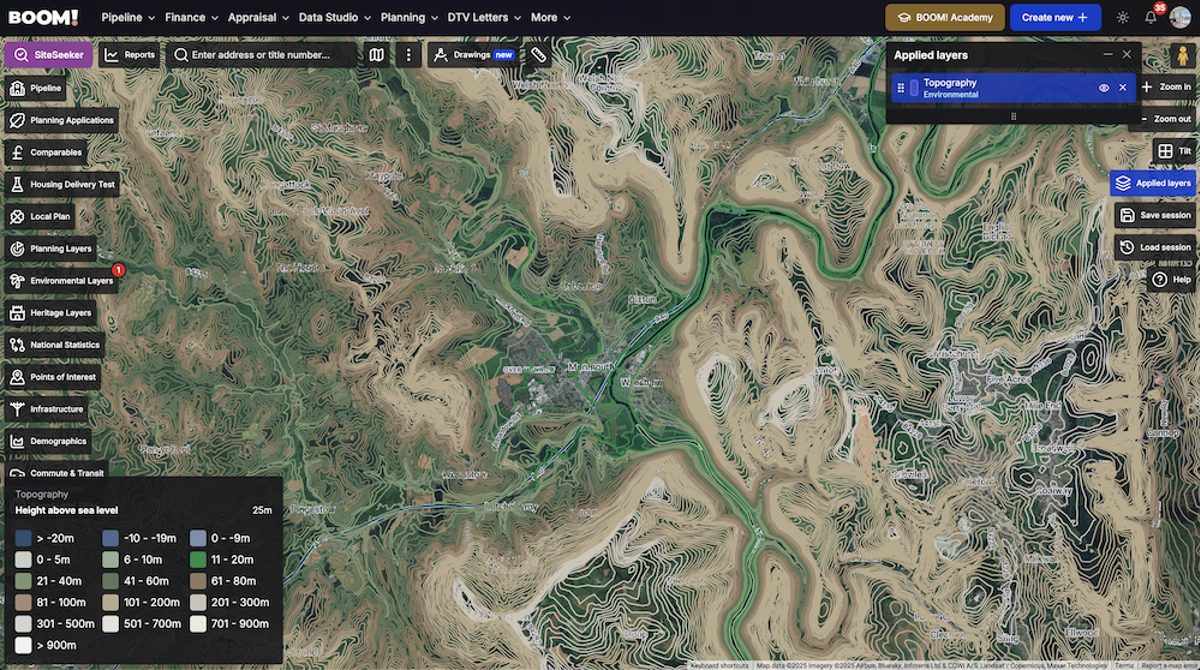Why Flat Land is Overrated (and How Savvy Developers Turn Terrain into Opportunity)







Picture this: You snag what looks like the perfect plot – it’s flat, easy, a “no-brainer” build. Then the first heavy rain hits and you’re wading through a surprise swamp. Meanwhile, a hilly site you passed on gets snapped up by another developer who carves out stunning split-level homes with panoramic views. The difference? Understanding topography – the shape and features of the land beneath your feet. It’s not just a geography term; it can make or break your project. In fact, about 6.3 million properties in England are in flood-risk areas (often low, flat sites), while some of the most sought-after homes sit on challenging terrain that others overlooked. Before you dive into your next deal, let’s arm you with insider terrain knowledge so you never miss these clues again.
What Is Topography (and Why Should You Care)?
Topography simply means a site’s elevation, slope, and aspect. In plain English: how high the land is, how steep it is, and which direction it faces. These might sound basic, but they decide whether a plot is a dream or a disaster for development. Elevation & Slope: Is the land level, gently rolling, or sharply sloping? A steep slope means less usable area and trickier construction, whereas gentle ground is easier to build on. Aspect: Which way the land tilts – north, south, east, west – affects how much sun, shade, and wind your site gets. All these factors directly impact build cost, design, and even end-value. Topography is basically the land telling you its story. Learn to read that story, and you’ll quickly spot risks and opportunities that others miss.
Hidden Risks: The Cost of Ignoring Terrain
Ignoring terrain can burn a giant hole in your budget (and confidence). Steep or uneven land often demands expensive extra work – think digging into hillsides, trucking in fill soil, building retaining walls, and beefing up drainage. Those engineering gymnastics cost time and money. In fact, building on a sloping site almost always costs more than on flat ground due to the cutting, filling and retaining required (costs that rise with steeper slopes). Foundations need special design on hills; unstable ground must be stabilised – all this can quickly add tens of thousands of pounds to your build. Steep slopes can even make a site completely undevelopable in extreme cases.
And don’t fall into the trap of thinking flat = safe. Flat, low-lying land can be a silent danger if it sits in a flood zone or has poor drainage. The UK’s latest data shows millions of properties are at risk of flooding – many on those “easy” flat plots near rivers or coasts. Build on a flood-prone site, and you might literally be underwater on your investment. (Flood insurance costs, anyone?) In short, if you skip the terrain homework, you’re gambling with your project’s timeline, budget, and viability. Every seasoned developer has a horror story about the plot that looked fine…until it wasn’t. Let’s make sure that doesn’t happen to you.
Hidden Opportunities: Turning Terrain into Your Secret Weapon
Here’s the part most newbies overlook: challenging terrain isn’t just a risk – it can hide golden opportunities. While many run away from slopes, savvy developers lean in and get creative. Hills and slopes can offer unique bonuses that flat land can’t match. Ever watch Grand Designs on TV? There’s a reason those show-stopping homes on cliff edges and hillsides steal the spotlight – jaw-dropping views and character that buyers love. A steep plot, if handled right, can become a standout development with split-level architecture, terraced gardens, and panoramic windows. Those features aren’t just pretty – they’re profitable. Homes with great views can command up to 54% higher prices than similar homes without views. Imagine selling a house with a sunset vista or a skyline outlook – you can bet buyers will pay a premium for that “wow” factor.
Terrain can also unlock niche uses. For example, a north-facing slope (often shunned for being too shaded) might be perfect for certain projects. Wind turbines or eco-homes? A slope facing away from the sun could be a prime candidate for small wind energy setups, and since south-facing homes tend to cost more, a north-slope site could be ideal for affordable housing where buyers trade a bit of sunlight for a lower price. Likewise, a site with big elevation changes might scare off average developers, which means less competition for you – and the chance to create something truly special. Hilltop locations naturally provide privacy, breezes, and a sense of exclusivity that modern buyers crave. In short, the very thing others see as a problem might be your competitive edge. By viewing topography as a feature, not a flaw, you can spot hidden gem sites and add features (like view decks or walkout basements) that boost end value and appeal.
Make Topography Your Secret Weapon
The takeaway is simple but powerful: let the land itself guide your decisions. Now that you know how to “read” topography, use it. Before you even call a solicitor or make an offer, check the terrain. The best part? You don’t need to be a surveyor or hike every hill in person. BOOM! puts topographic insight at your fingertips – see detailed elevation, slope gradients and aspect in seconds. With a few clicks, you can see if that peaceful field hides a 2-meter drop or if that hillside has a gentle buildable section. Knowledge equals speed and confidence: you’ll quickly rule out no-go sites and zero in on the winners. While others waste weeks on a dud plot, you’ll be focusing only on sites that match your plans.
Every day you wait to factor in terrain is a day a competitor might snag a deal you overlooked – or worse, a day closer to uncovering an expensive surprise on your project. So start treating topography as your new must-check item (right up there with location and price). Walk the site if you can, study the contour lines, and envision both the challenges and the creative solutions the land suggests. By doing so, you’ll de-risk your developments, impress funders and planners with your due diligence, and find value where others see headache. In a game as competitive as property development, this is your edge. The land is whispering its secrets – now you have the ears to listen. Use this knowledge, get out there, and turn terrain into your opportunity. Your future projects (and profits) will thank you for it.
To find out how BOOM! can help book in a call with our team.